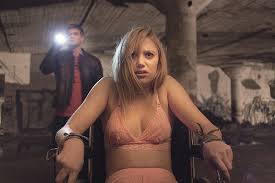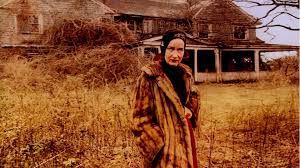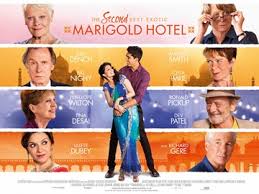David Robert Mitchell’s independent horror film It Follows did well on the festival circuit and is gathering some positive reviews, but its box office opening is soft.
I find myself a little ambivalent about the film but am calling on a former student who knows much more about horror films than I do to enlighten me!
Not only was Dan Bagwell a delight for me to work with in several classes when he was a graduate student at Wake Forest University, but he made horror films the focus of his master’s thesis.
Mary: Let’s start out by having you talk a little bit about your thesis. At the risk of sounding annoyingly arch, what is the thesis of your thesis?
Dan: My thesis focuses on the societal significance of “body horror” films. Specifically, I analyzed depictions of the grotesque human body in David Cronenberg’s Videodrome in relation to broader social fears surrounding gender, mortality, and human identity. I think that the horror genre (unfairly) gets a bad reputation among many moviegoers and critics, and I wanted my thesis to demonstrate the rhetorical power of the genre and how horror films can tell us a lot about the psyche of the general public.
Mary: In a message you sent me last night, you called It Follows “one of the best horror movies that deals with gender/sexuality that I’ve seen” and highly recommend it. What makes this film a standout for you?
Dan: The film really stood out to me both technically and thematically, especially in comparison to many contemporary horror films. On a technical level, the film is incredibly well-made; the use of long takes and wide shots help build and sustain an unsettling atmosphere, and Mitchell does an excellent job of staging horrific scenes in both claustrophobic and open spaces. It’s rare for a film to require that attention be paid to every inch of the screen, but I found myself anxiously scanning the background the entire time.
The antagonist (I can only really call it “It”) is one of the most horrifying creatures in horror cinema. I’m fascinated by the idea of a creature that is constantly moving and reinventing itself for one singular purpose, which adds a sense of inevitable doom and staying power to the film. Some of my favorite films reveal very little about their antagonists (The Blair Witch Project, No Country for Old Men, The Dark Knight), and It Follows strikes a perfect balance between revealing just enough detail about “It” while leaving plenty to the imagination.
Thematically, I thought It Follows took a very clever twist on some typical horror conventions that symbolize prominent fears that we all share in some form or another. Mitchell’s film dispenses with the “survivor girl” archetype, which features virginal women triumphing over their male attackers while their sexually active friends perish. It Follows casts sexuality as a malevolent force that attaches itself to Jay, a young woman who is constantly haunted by a single act of intimacy. Take your pick of what “It” symbolizes; the monster can be read as a personification of any number of persistent issues that plague the broader public.
Mary: Why do you think it seems to be connecting better with critics than the average horror flick fan?
Dan: I think that creativity and consistency are factors that critics appreciate in horror films, primarily since so many films released now are more in the “by-the-numbers” slasher camp; it’s rare for a horror film to deliver on an interesting premise for the entire 1.5 hours. Take The Purge, for example; the consensus seemed to be that, despite an interesting central idea, it collapsed into typical home invasion fare. It Follows, on the other hand, is relentlessly scary up to the final shot without feeling like a re-hash of tired slasher conventions. Too many horror movies confuse gore for scares, and It Follows seems to resonate with people (myself included) by combining a consistently unnerving atmosphere with an intriguing and terrifying monster.
Mary: Do you have a preferred reading of sexual encounters as metaphorical in this film?
Dan: I think “It” can be a stand-in for our unease toward a variety of things surrounding sex, from disease to sexual assault to social construction of what it means to be a sexual being. Just as the characters in the film are constantly haunted by “It,” the themes in the film speak to inescapable sexual issues faced by society as a whole.
Some critics have read the film as an allegory for STDs, which makes a lot of sense to me given the social prominence of that issue and “It’s” sexually-transmitted nature. There are several tracking shots of disadvantaged, downtrodden neighborhoods that could also support this interpretation, which could be read as a nod to how disease is especially prevalent in marginalized areas.
My preferred reading of the film, however, is centered on the relation between sex and societal attitudes toward women. I think the theme of a teenage girl being constantly hounded by a past sexual encounter is a symbolic one that speaks to how, for the most part, women bear a disproportionate burden when it comes to sexual consequences. Women are often stigmatized for being sexually active in ways that men are not, prompting cycles of “slut shaming” that unfairly frame women as deviants. Jay’s sexual past becomes inescapable, which problematizes the specters of sexual stigma that women face on a daily basis. The fact that Jay’s curse is transmitted to her by a man (who also drugs her) is also important; while they both participate in the act, we see the woman facing nearly all of the consequences, much to the relief of the male.
I’ve always been fascinated by Laura Mulvey’s idea of the “male gaze,” or the theory that women are often constructed cinematically for the visual pleasure of men. It Follows is an interesting case study for Mulvey’s theory, especially since “It” constantly has its eyes fixated on its female victim. I think the shape-shifting nature of the monster can be read as a metaphor for the unyielding gaze of the masses upon the female body, which becomes a threatening force in itself.
I was reminded of Mitchell Lichtenstein’s Teeth, another horror movie that incorporates themes of sexuality as a destructive, monstrous force. While the protagonist of Teeth uses her sexuality as a weapon against her attackers, It Follows positions Jay on the receiving end of sexual violence. Jay is framed as a sympathetic victim of tragic circumstance who must face “It’s” merciless advances.
It Follows is a film that I can’t wait to revisit. If ever there was a modern horror movie that deserved academic attention, I think Mitchell’s film would make the short list.
Mary: Is there something you’d like to say about It Follows that I didn’t ask you?
Dan: I think that music can make or break horror movies, and the soundtrack for It Follows is pretty outstanding. The music is appropriately sinister and abrasive, which helps keep the tension alive even when “It” isn’t present. I couldn’t relax until I left the theater. It was a great throwback to the sort of music I’d expect from a John Carpenter film, which gave a very welcome retro vibe for me. Some of the best horror movies are masterpieces even when muted; It Follows would even be incredible without video. I’d love to hear your thoughts on It Follows. As a horror devotee, I may be seeing it through rose-colored glasses.
Mary: I understand — and appreciate — that by not being “spot on” in terms of the narrative or leaving a lot of ambiguity to “It” that the film is breaking with convention, and I’m all about breaking with convention, especially in genres that are well-represented on the screen. Still, I wanted a bit more of a pattern in how “It” operates. If, for example, the women characters were not able to shed “It” with another sexual encounter while the men were (or, at least, were mostly able to), then I would have an easier time with your reading, which I really like. I do think women bear, as you put it, a disproportionate share of sexual consequences, but “It” seems to be an equal opportunity terror (Greg [Daniel Zovatto] suffers perhaps the most horrendous fate depicted in the film). I have to say, however, that I liked the style of the film and the performances. Maika Monroe is terrific as the main character, Jay, but Keir Gilchrist’s Paul is my favorite character in large part because of his performance. So, I liked It Follows, but I think I was hoping for a bolder, more incisive feminist statement. You seem to have found enough there to support your reading, but I needed a little bit more, which David Robert Mitchell is not obligated to give me. I’m talking about my political project here rather than his artistic one.
Thanks, Dan! We’ll have to do this again.




